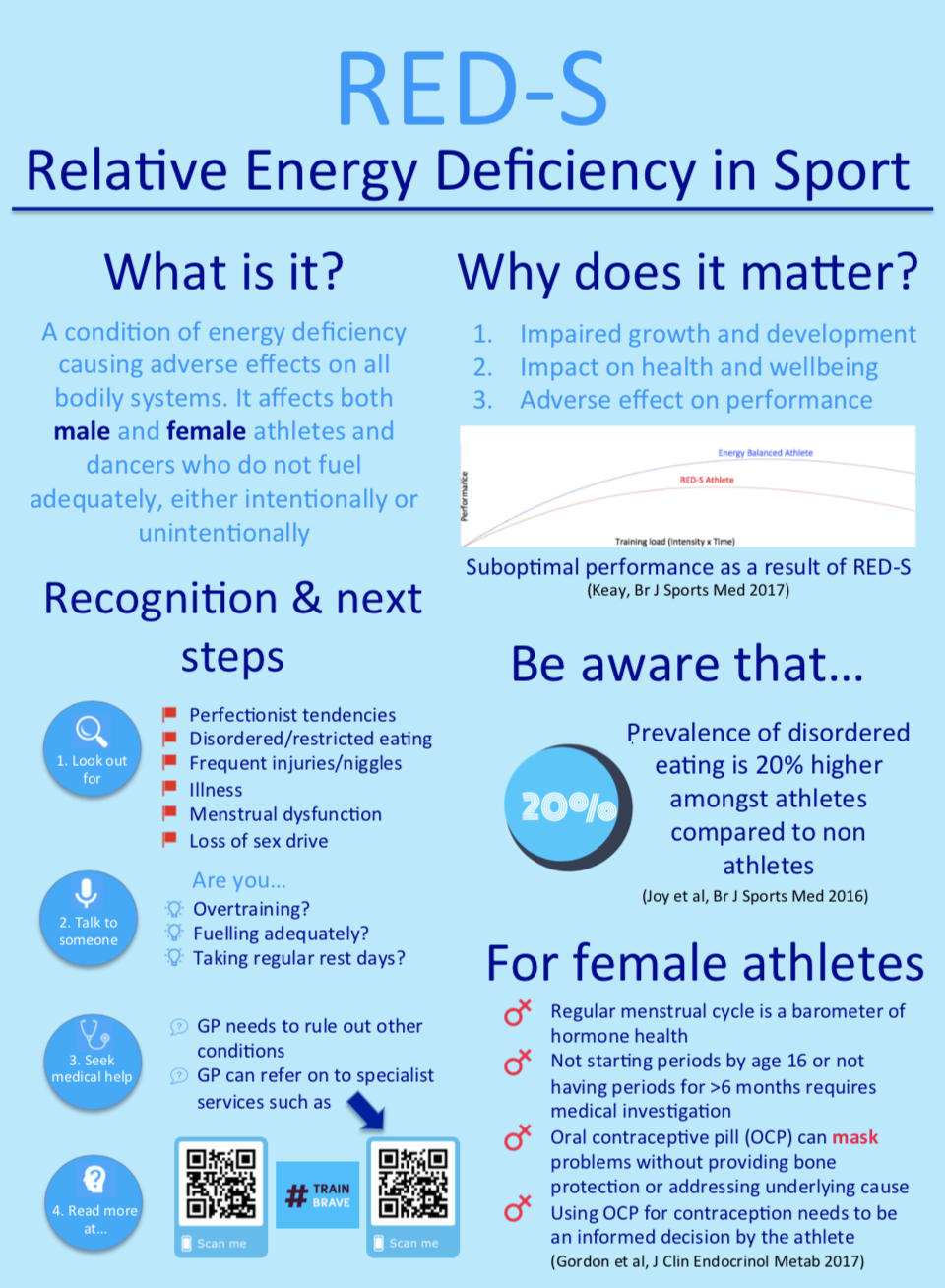By Emily Dudgeon
Relative energy deficiency in sport (RED-S) is a condition of low energy availability affecting male and female athletes of all levels and ages [1]. It has wide ranging adverse effects on all bodily systems and can seriously compromise long term health and performance [2]. Athletes affected by RED-S have openly spoken about consequences such as osteoporosis and its devastating impact on their quality of life and performance [3]. An International Olympic Committee (IOC) Consensus Statement was published on the condition back in 2014, but RED-S still remains poorly recognised by health professionals, coaches and athletes [4,5].
Why do some athletes/dancers experience low energy availability?
Restricted eating and overtraining may put athletes/dancers at risk of developing RED-S. Disordered eating and formal eating disorders exist on a spectrum of eating behaviours. The eating habits of athletes/dancers differ from that of non-athletes, and are found closer to the pathological end of the spectrum. Compared with non-athletes, a smaller change in eating behaviour is required for an athlete to develop pathological eating behaviours. There is a 20% higher prevalence of disordered eating in both male and female athletes than in non-athletes [6].
Another reason is an athlete’s personality type. Perfectionism is often seen as desirable in sports people, but it is linked to eating disorders [7]. Athletes/dancers are rewarded for, and sometimes picked out as having great potential because of, their “excessive conscientiousness”, “rigidity” and a “preoccupation with details”, all of which are considered pathological under different circumstances [8].
Finally, the pressure an athlete experiences in their environment may result in an eating disorder. Athletes may believe they must look a certain way, eat certain things or do a certain number of training sessions. Pressure to conform to what people expect of an athlete can come from family, friends, the sport more widely, your coach, the media and perhaps most of all, from social media.
The prevalence of RED-S is also high amongst athletes who do not suffer from disordered eating [9]. High training load with unintentionally inadequate fuelling or lack of recovery can contribute to RED-S in these athletes.
Every athlete should be treated as an individual, and their training must be appropriate for them, taking into account factors such as training experience, physiological maturity, biomechanics and how they respond to different sessions.
Female athletes affected by RED-S
Female athletes who suffer from oligomenorrhea or amenorrhea may be advised that taking the oral contraceptive pill (OCP) will address their symptoms. The OCP masks menstrual disturbance without providing adequate bone protection. In fact, hormone replacement therapy (HRT) provides superior bone protection compared to the OCP [10]. If an athlete chooses OCP for contraception, it is important that this is an informed decision taking into account their risk factors for RED-S and requirement for bone protection.
Recognition and next steps
Several barriers exist to getting RED-S sufferers the help that they need. Seeking medical help is an important first step, as other conditions must be excluded. Initiatives such as #TrainBrave have been established in an effort to increase awareness of RED-S and combat myths that encourage high risk behaviours amongst athletes, such as “lighter is faster” [11]. The website Health4Performance is another great resource for those wishing to find out more [12]. There is now a specialist NHS RED-S clinic in London that receives support from the National Institute of Dance Medicine and Science (NIDMS) [13]. This is a much needed first step in establishing a clinical pathway for those affected by RED-S.
We have created the below infographic to increase awareness amongst healthcare professionals, coaches and athletes across the UK. We would like to encourage an multidisciplinary approach in sport and dance by working with governing bodies, grassroots clubs and healthcare professionals.

***
References
- 1 Mountjoy M, Sundgot-Borgen J, Burke L, et alThe IOC consensus statement: beyond the Female Athlete Triad – relative energy deficiency in sport (RED-S). Br J Sports Med 2014;48:491–7. doi:10.1136/bjsports-2014-093502
- 2 Constantini N. Medical concerns of the dancer. IMS World Congress of Sports Medicine. Budapest, Hungary, 2011.
- Clay, B. “My osteoporosis nightmare”. Athletics Weekly. https://www.athleticsweekly.com/performance/bobby-clay-my-osteoporosis-nightmare-70422/(Accessed 06/04/2019)
- 4 Curry EJ, Logan C, Ackerman K, et al. Female athlete triad awareness among multispecialty physicians. Sports Med Open2015;1:38. doi:10.1186/s40798-015-0037-5
- 5 Miller SM, Kukuljan S, Turner AI, et al. Energy deficiency, menstrual disturbances, and low bone mass: what do exercising Australian women know about the female athlete triad? Int J Sport Nutr Exerc Metab 2012;22:131–8. doi:10.1123/ijsnem.22.2.131
- 6 Joy E, Kussman A, Nattiv A 2016 update on eating disorders in athletes: A comprehensive narrative review with a focus on clinical assessment and management Br J Sports Med 2016;50:154-162.
- 7 Haase A.M., Prapavessis H.R.G., Owens R.G. (2001) Pefectionnism, social physique anxiety and disordered eating: a comparison of male and female elite athletes. Psychology Sport Exercise 33, 209-222
- 8 WHO. ICD-10 2015. https://icd.who.int/browse10/2015/en#/F60.5(Accessed 06/04/2019)
- 9 Melin A, Tornberg ÅB, Skouby S, et al. Energy availability and the female athlete triad in elite endurance athletes. Scand J Med Sci Sports 2015;25:610–22. doi:10.1111/sms.12261
- 10 Gordon CM, Ackerman KE, Berga SL, et al. Functional hypothalamic amenorrhea: an endocrine society clinical practice guideline. J Clin Endocrinol Metab 2017;102:1413–39. doi:10.1210/jc.2017-00131
- 11 Fairbrother, T, McGregor, R. #Trainbrave. https://trainbrave.org/(Accessed 06/04/2019)
- 12 Keay, N et al. Health4Performance. http://health4performance.co.uk/(Accessed 06/04/2019)
- 13 Royal National Orthopoedic Hospital. “New Clinic for Dancers”. https://www.rnoh.nhs.uk/home/news/19/01/new-clinic-for-dancers-rnoh(Accessed 06/04/2019)